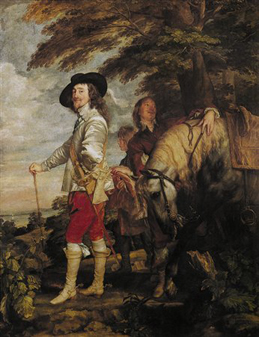98. Anthony van Dyck, Charles I at the Hunt, 1635.
Oil on canvas, 266 x 207 cm. Musée du Louvre, Paris.
In those days, Van Dyck was not yet the gallant flatterer that he later became, being spoiled by the favour of the Court and the aristocracy. For this reason the pictures of this period persuade with the simple truth, such as Portrait of Duke Wilhelm von Pfalz-Neuburg (c. 1628), Portrait of Justus van Meerstraeten (1634-1635) and several others. It can hardly be doubted that Van Dyck recognized the deep inner spirit of these men and translated its external appearance skilfully. However, the best of his Antwerp portraits is certainly the Portrait of Maria-Luisa von Tassis (c. 1630), in which he perfectly executed the facial features, as well as the richness of her clothing and jewels.
This painter, who knew how to satisfy all the wishes of a demanding and pleasure-seeking aristocracy, also knew how to gain the full approbation of the other artists. In those years of his stay in Antwerp he painted them all, whether painter, sculptor, musician or architects, alone or with their wives. Among these portraits is that of the sculptor Andreas Colyns de Nole and the double portrait The Painter Frans Snyders and his Wife (early seventeenth century). All these portraits show with what seriousness and eagerness Van Dyck used his great knowledge in the service of his poorer artist friends who could hardly pay for his work. As Van Dyck, in the course of time, saw that the list of those painted and famous personalities became longer and longer, he had the idea of having them reproduced by means of copper engravings. From this originated the famous Van Dyck’s Iconography, which eventually comprised 190 sheets.
